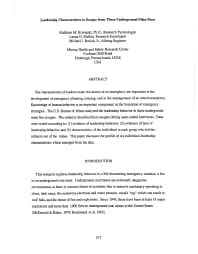Mining Publication: Leadership Characteristics in Escape from Three Underground Mine Fires
Original creation date: May 1996
Authors: KM Kowalski, LG Mallett, MJ Brnich
NIOSHTIC2 Number: 20032536
TIEMEC '96: The International Emergency Management and Engineering Conference 1996, May 28-31, 1996, Montreal, Canada. Wybo JL, Therrien MC, Guarnieri F, eds., Dallas, TX: The International Emergency Management and Engineering Society, 1996 May; :317-326
The characteristics of leaders under the duress of an emergency are important in the development of emergency planning, training, and in the management of an actual emergency. Knowledge of human behavior is an important component in the formation of emergency strategies. The U.S. Bureau of Mines analyzed the leadership behavior in three underground mine fire escapes. The subjects described their escapes during open-ended interviews. Data were coded according to: (1) evidence of leadership behavior, (2) evidence of lack of leadership behavior, and (3) characteristics of the individual in each group who led the subjects out of the mines. This paper discusses the profile of six individual leadership characteristics which emerged from the data.

NIOSHTIC2 Number: 20032536
TIEMEC '96: The International Emergency Management and Engineering Conference 1996, May 28-31, 1996, Montreal, Canada. Wybo JL, Therrien MC, Guarnieri F, eds., Dallas, TX: The International Emergency Management and Engineering Society, 1996 May; :317-326
- Behavioral and Organizational Dimensions of Underground Mine Fires
- The Critical Ventilation Velocity in Tunnel Fires - A Computer Simulation
- Decision Making During a Simulated Mine Fire Escape
- Emergency Management
- Emerging Technologies: Aiding Responders in Mine Emergencies and During the Escape From Smoke-Filled Passageways
- Fire Response Preparedness for Underground Mines
- Knowledge Management and Transfer for Mine Emergency Response
- Mine Rescue and Response
- An Oral History Analysis of Mine Emergency Response
- Responders to Underground Mine Fires